If you’re not into streaming, then you’re oh-so-yesterday.
Streaming is the “in” thing in the world of gaming entertainment, and we’re certainly not complaining. From live-streaming the latest RPG to binging on the best streams on Twitch, gamers today have a vast number of options when it comes to streaming.
In fact, streaming is not only limited to gamers, as every profession, from tech to academics, can use this mode of content delivery. But to be a successful streamer, you need the best laptop for streaming. And that’s where things can get tricky with so many models on the market.
But as always, we’ve selected the creme-de-la-creme of streaming laptops to help you get over that problem. We’ve even thrown in a guide on how to set up your streaming laptop, so make sure you stick around till the very end.
Let’s get the streaming started…
Table of Contents
Best Laptop For Streaming Reviews
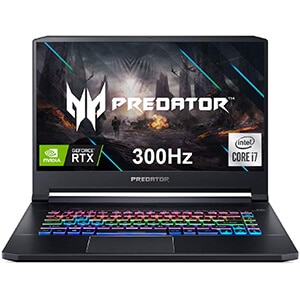
1. Acer Predator Triton 500
- Display: 15.6” 1080p 300Hz
- CPU: Intel Core i7-10750H
- GPU: NVIDIA GeForce RTX 2070 Super
- RAM: 16 GB
- Storage: 512GB SSD
Acer’s Predator Triton 500 series is a big hit among gamers the world over, but did you know that it can double as a great streaming laptop as well? With an Intel Core i7-10750H processor running the show, aided by an equally able graphics module and ample memory, this is one gaming laptop that’s ideal for streamers.
Processing Power
As we’ve already mentioned, this laptop runs on a 10th gen Intel Core i7 processor, with six processing cores working in tandem to provide clock speeds up to 5.0 GHz. Along with that, you also get an Nvidia GeForce RTX 2070 graphics card with a massive 8 gigs of GDDR6 VRAM.
This powerful processing system is ably accompanied by 16 GB of DDR4 RAM working at 2933 MHz. Overall, this combination allows you to run multiple browser tabs and use different streaming tools and streaming services simultaneously. All this makes this one of the best laptops for live streaming.
Storage
You don’t really need us to tell you that traditional storage (AKA HDDs) can make your laptop notoriously slow. Thankfully, this laptop comes with 512 GB of PCIe NVMe SSD for spacious storage and smooth operation. And in case you need extra space, you can always add another SSD.
Connectivity
Connectivity options play a significant role in streaming, and this laptop pays attention to it. It comes with multiple display outputs, along with triple USB 3.0 ports, WiFi, Bluetooth, and even a USB Type-C connector. There’s also a separate mic-in port and another dedicated one for headsets/speakers. Add to that the standard HDMI and RJ-45 ports, and you’ve got connectivity par excellence.
Build And Appearance
Build-wise, this is one of the thinnest gaming laptops we’ve come across at just 0.70 inches. The sleek design is complemented by the 15.6-inch FHD G-SYNC display that offers refresh rates of up to 300 Hz. And if you’re a stickler for RGB (just like us), you’ll love the per-key backlit RGB keyboard that’s built for gamers and streamers. Certainly an excellent bang for your buck!
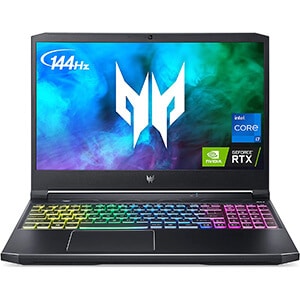
2. Acer Predator Helios 300
- Display: 15.6” 1080p 144Hz
- CPU: Intel Core i7-11800H
- GPU: NVIDIA GeForce RTX 3060
- RAM: 16 GB
- Storage: 512GB SSD
For those looking to get a modern laptop that works equally well as a gaming laptop and the best laptop for live streaming, then Acer Predator Helios 300 is the one for you. Granted, it’s not exactly a budget laptop, but the power that you get is certainly worth the spend.
Processing Power
The Predator Helios 300 takes streaming games a notch above with its 11th generation Intel Core i7 octa-core processor supporting 16 threads. Along with that, you get 6GB of dedicated Nvidia GeForce RTX 3060 GDDR6 VRAM that’s powered by Ampere architecture.
The above, together with 16 GB of DDR4 RAM (expandable to 32 GB) with 3200 MHz clock speed, provides you a smooth gaming and streaming performance. With this laptop on your table, you won’t have to face continuous lags, frame drops, and similar disturbances even when streaming extremely graphics-intensive games at FHD resolutions.
Storage
Storage shouldn’t be a problem with 512 GB of PCIe Gen 4 SSD. And if you wish to expand your storage further, you have two PCIe M.2 slots, along with a 2.5-inch HDD bay. By the way, don’t worry about all these components generating too much heat. The Predator Helios 300 is equipped with an 89-blade, 5th generation AeroBlade fan that ensures enhanced air intake and more than sufficient cooling.
Connectivity
Let’s talk about the connectivity options next, which are more than decent by any standards. This laptop has four USB 3.0 ports, which means you have ample scope of attaching a separate mic even after connecting other gaming peripherals. You also get standard connections such as WiFi for smooth internet connectivity.
Build And Appearance
Let’s admit one thing first: this laptop is a heavy machine weighing a little over five pounds. But the rugged and durable body with RGB backlit keyboard makes sure you don’t pay too much attention to the weight.
Coming to the display, you get a 15.6-inch FHD IPS screen with a 144 Hz refresh rate and 3 ms response time for stunning visual experiences. Also, the Li-ion battery ensures you get up to six hours of battery life for uninterrupted gameplay on a full charge.

3. Asus TUF Dash 15
- Display: 15.6” 1080p 144Hz
- CPU: Intel Core i7-11370H
- GPU: NVIDIA GeForce RTX 3050 Ti
- RAM: 16 GB
- Storage: 512GB SSD
While the above options are great gaming laptops and suitable for streaming, they do come with a high price tag. So, this time we have a slightly affordable option in the Asus TUF Dash 15. Launched in 2021, this eclipse gray device is sure to steal your heart by its looks alone.
Processing Power
Thankfully for us, looks aren’t the best thing about this system. It’s powered by an 11th generation Intel Core i7 processor (octa-core), supported by an Nvidia GeForce RTX 3050 Ti GPU. This deadly processing combo ensures you face zero lags while streaming your favorites.
What’s more, the GPU comes with the option of using Dynamic Boost 2.0, which helps deliver incredibly high frame rates. Granted, the 8 GB of DDR4 RAM seems a bit low compared to the previous options, but it’s sufficient for streaming most games even at a high resolution.
Storage
This laptop doesn’t cut any corners in storage and includes the standard 512 GB SSD for faster tertiary storage access. This is accompanied by a reliable, 83-blade cooling system that’s self-cleaning. It also uses five heat pipes and four fan outlets to draw heat away from the internal components, thus enhancing the performance and longevity of the laptop.
Connectivity
The three USB 3.0 ports that this device comes with ensuring that you can connect your gaming pad, mouse, and mic suitably. Along with that, you also get an HDMI 2.0b port, a DisplayPort 1.4 over Type-C ThunderBolt 4, and WiFi 6 and RJ-45 inlets for seamless internet connections.
Build And Appearance
Asus TUF laptops are usually built to last with military-grade toughness, and this model is no exception. In addition, these laptops are shipped only after being put through rigorous MIL-STD-810H tests that expose them to extremes of temperatures, drops, vibrations, and humidity. As a result, your device can easily tackle the occasional knock and bump while on the go.
Finally, we need to mention the FHD IPS display with refresh rates of 144 Hz and adaptive sync that delivers stunning visuals on account of the dedicated GPU. Stuttering, frame-drops, and visual tearing are a thing of the past with this combination. And you can certainly expect a good battery life from this laptop, even if you’re a heavy user.

4. Apple MacBook Air M1
- Display: 13.3” Retina display
- CPU: Apple M1 Chip
- GPU: 8-core GPU
- RAM: 8 GB
- Storage: 512GB SSD
We have been discussing a few good laptop models till now, but as you might have noticed, they were all Windows-based. Now, we come to the Apple MacBook Air, powered by the brand’s very own M1 SoC coupled with MacOS Big Sur. Needless to say, this latest iteration of the MacBook delivers a unique streaming platform that’s precisely what you need to succeed in today’s fast-paced world.
Processing Power
The MacBook Air is Apple’s lightest and thinnest laptop and features a fanless design powered by the M1 SoC octa-core processor. It provides speeds up to 3.5-times faster than a regular CPU and integrates CPU, GPU, and the Apple Neural Engine onto the same chip. Such intense customization ensures that you get blazing fast speeds.
Another significant aspect of the M1 chip is that it works with very little power consumption, thus offering a battery life of up to 18-hours. You also get 16 GB of unified system memory that allows low-latency data sharing between the SoC components. Overall, a different level of computing altogether.
Storage
The MacBook Air supports up to 2 TB of SSD storage, which is more than sufficient to store your digital data. At the same time, the SSD quality on this system works together with the processing unit to deliver twice the speed of regular SSDs. Also, keeping data on the MacBook Air ensures it’s protected by the most advanced security and privacy features in its class.
Connectivity
Many people rue the fact that this laptop doesn’t come with regular USB ports, but that’s simply because it doesn’t need them. Instead, it’s equipped with the next generation of wireless connectivity (WiFi 6), along with fast data transfer, video output, and charging via Thunderbolt. As a result, connecting your devices becomes a matter of simplicity itself.
Build And Appearance
Build-wise, MacBooks truly have no match. The 13.3-inch Retina display ensures that you can stream and view videos vividly. Sharp texts, brighter colors, and vibrant graphics set this model apart from other streaming laptops. Further, the fanless design ensures calm and quiet operation, as does the preprogrammed backlit keyboard with a scissor mechanism and ambient light sensors.
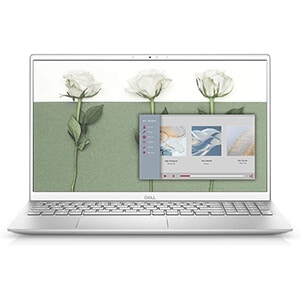
5. Dell Inspiron 15 5502
- Display: 15.6” 1080p
- CPU: Intel Core i5-1135G7
- GPU: Iris Xe Graphics
- RAM: 8 GB
- Storage: 512GB SSD
We get it: you might be one of those die-hard Windows fans who swear by a PC. If that’s the case, then here’s the Dell Inspiron 15 5502 that’s capable enough to handle regular streaming tasks. Although it’s not nearly as powerful as some of our previous options in the gaming laptop range, it’s still one of the best there is when it comes to streaming.
Processing Power
Under the hood, this unit runs an 11th generation Intel Core i5 processor that’s clockable up to 4.2 GHz, sufficient for most streaming operations. And although it doesn’t have a separate GPU, the 8 MB cache and integrated Intel Iris Xe Graphics can easily handle fairly heavy games.
Added to this mix is the 8 GB 3200 MHz DDR4 RAM, enabling you to multitask at the speed of thought. The combination ensures that you can get a streaming performance that matches many higher-end laptops, even with a quad-core processor onboard.
Storage
As usual, this laptop comes with a 512 GB onboard SSD that offers fast performance. But if you feel the need, you can also extend storage using an HDD, as the motherboard has a SATA interface for that purpose. Long story short, you don’t need to worry about storage when you’re using this laptop.
Connectivity
You can experience seamless connectivity with this Dell Inspiron 15 model as it comes equipped with Bluetooth, WiFi, and multiple USB 3.0 ports for attaching peripheral devices. And though the webcam is a bit disappointing, it’s more than compensated by the Li-ion battery, which provides a decent battery life of up to seven hours.
Build And Appearance
Let’s talk a bit about the build quality and looks of this product next. First, it comes in all-silver, which looks rather dazzling even in dim-light situations. Along with that, the 15.6-inch FHD anti-glare display provides excellent viewing angles and a large viewable area with narrow bezels.
The raised hinge further adds to the viewing and typing comfort, as does the fully backlit keyboard that allows typing in low-light situations. It even packs a fingerprint reader and lid-open sensor that helps to turn on the laptop faster and with greater ease—certainly a powerful laptop for streaming purposes.
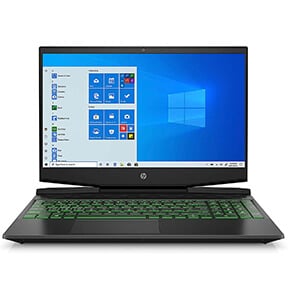
6. HP Pavilion Gaming 15
- Display: 15.6” 1080p
- CPU: Intel Core i5-10300H
- GPU: NVIDIA GeForce GTX 1650
- RAM: 16 GB
- Storage: 256GB SSD
No list that deals with streaming or gaming laptop models can be complete without HP, and the HP Pavilion Gaming 15 model proves it. One of the latest models from the brand features a 15.6-inch Micro-EDGE screen that practically does away with the bezel. But that’s not the only aspect of this laptop that we love.
Processing Power
Powered by a 10th generation Intel Core i5 processor and an Nvidia GeForce GTX 1650 4 GB graphics card, this is one of the best laptops that you can get for streaming. The four cores of the CPU can be clocked up to 4.5 GHz, which is certainly enough for streaming videos.
To enable smoother multitasking, the HP Pavilion Gaming 15 comes with 16 GB of DDR4-2400 SDRAM, which ensures you can switch between multiple tabs and windows with ease. And all this comes packed in a stylish package that weighs just under five pounds.
Storage
This is the only aspect that can be considered a con of this laptop, as it comes with only 256 GB of SSD storage. Granted, the SSD ensures faster data transfer and quick boot-ups, but in today’s age of data explosion, just 256 GB seems measly. However, you can always back it up with an external SSD if you want.
Connectivity
Thankfully, connectivity is not a problem when it comes to this laptop. It comes with integrated LAN, WiFi, and Bluetooth interfaces for seamless connectivity. Also, there are two USB 3.1 ports, one USB Type-C port, and the standard HDMI and RJ-45 interfaces.
You also get a headphone/mic combo and dual stereo speakers supported with audio by B&O. For video calls, you can use the integrated webcam and dual array digital mic.
Build And Appearance
This unit’s Shadow Black/Acid Green color combination is striking, as is the WLED-backlit, anti-glare IPS display with a 60 Hz refresh rate. We also like the full-size, island-style backlit keyboard that enables you to work in low-light situations. All this is ably supported by eight hours of battery life, which means you can work (and play) uninterrupted even on the go.
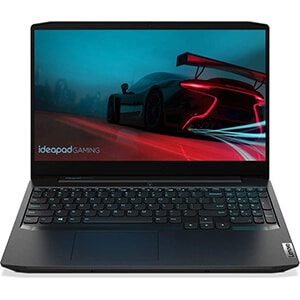
7. Lenovo Ideapad Gaming 3
- Display: 15.6” 1080p 120Hz
- CPU: AMD Ryzen 5 5600H
- GPU: NVIDIA GeForce GTX 1650
- RAM: 8 GB
- Storage: 256GB SSD
We’re almost at the end of our list, but before wrapping up, we’d like to mention the Lenovo Ideapad Gaming 3 laptop, which is undoubtedly the best budget laptop on our list. It comes with a full HD screen, Windows 10 operating system, and a powerful AMD processor that makes streaming videos an effortless and enjoyable job.
Processing Power
This laptop is powered by the AMD Ryzen 5 5600H Hexa-core processor that provides impeccable performance for all gaming and streaming scenarios. Add to that the Nvidia GeForce GTX 1650 GPU and 8 GB of DDR4 RAM at 3200 MHz, and you’ve got a device that’s ideal for full HD resolution streaming.
Storage
Again, the permanent storage front is where this laptop lacks, just like our previous offering. It comes with only 256 GB of M.2 PCIe SSD storage, which you might have to augment with an external storage device. However, the faster boot times are certainly a positive that you will enjoy.
Connectivity
When it comes to the connectivity options, this model packs in quite a lot of features. It includes an RJ-45 port, dual WiFi adaptors, and a Bluetooth 5.0 interface for fast wireless data transfers. Added to that are the usual HDMI and USB Type-C ports, 720p HD webcam, and a microphone array with privacy shutters.
And yes! We almost forgot to mention the dual speakers with Nahimic audio that makes gaming on this laptop a delight.
Build And Appearance
Build-wise, this is a sturdy model, and the shadow black color with backlit keyboard looks excellent, especially in the dark. In addition, the laptop weighs just under five pounds, which makes it easy to carry around in a backpack.
Also, similar to all the laptops mentioned on this list, this one too boasts a good battery life of over eight hours. So overall, whether you’re keen on streaming movies or games, this new laptop can undoubtedly take care of your streaming needs. All you have to get is a high-speed internet connection, and you’re good to go.
How To Setup Your Laptop For Streaming Games?
So, now that you’ve got a laptop with (preferably) a thin and light design and long-lasting battery life, we’re sure you’re ready to stream to your heart’s content. However, just a laptop that’s got enough internal hardware for playing games isn’t enough for streaming. You need a suitable streaming setup, and that means a few additional equipments.
In this section, we’re going to give you a peek into the accessories that you need for setting up your laptop for streaming games. Using this checklist, you can precisely set up your system to start streaming with ease.
Game Streaming Accessories Checklist
Laptop
As you might have guessed already, the first and most crucial requirement for streaming games is a good streaming laptop (like the ones mentioned above). While you don’t need an extremely powerful laptop for streaming, you should get a decent laptop with a powerful processor, at least eight gigs of RAM, an SSD, and as many USB ports as you can get.
While most gaming laptops can take care of these specifications, you should create a checklist of sorts that can help you with choosing the best laptops for live streaming. If you’re going for an Intel-powered laptop, make sure it comes with Intel HD graphics (preferably integrated Intel UHD graphics) or an additional graphics card.

Camera
Next, a webcam is a must for any streamer worth their salt. True, you can always use the integrated webcam on your laptop, but in most cases, streamers prefer an external, high-quality webcam. However, if you’re a beginner, we recommend going with a laptop with an integrated HD webcam.

Microphone
While most laptops come with integrated multi-array mics, which provide decent results, professional streamers recommend you work with an additional external mic. This ensures that you can position the mic precisely as per your needs and capture your voice independent of the game audio.
Keep in mind that the audio also plays an important part in the stream’s video quality. The kind of mic you choose depends on your gaming setup and environment, of course. For example, if you’re gaming in a stationary setup, condenser mics are a great choice as they can eliminate ambient noise.
If your streams are more dynamic, you can also use a lapel mic (wired or wireless). And if you’re planning to use the microphones with a mixer, then make sure they have an XLR interface and suitable audio cables.

Audio Mixer
Using an audio mixer will enable you to use multiple mics and simultaneous audio sources in your stream without interference. There are many mixer options available, and the one aspect you need to pay extra attention to is the number of inputs it has. Also, make sure the mixer has a USB output so that you can easily transfer it to your laptop.
- Whether you are new or a seasoned broadcast pro, the RODECaster Pro Podcast Production Studio is all you will ever need
Prices pulled from the Amazon Product Advertising API on:
Product prices and availability are accurate as of the date/time indicated and are subject to change. Any price and availability information displayed on [relevant Amazon Site(s), as applicable] at the time of purchase will apply to the purchase of this product.
Streaming Software
This is the one essential aspect of game streaming that you can’t ignore. The streaming software is essentially an encoder that takes audio and video from multiple inputs and streams to the platform you choose.
There are many options when it comes to streaming software, some free and most paid. Some standard tools you can try out are OBS Studio, StreamLabs OBS, vMix, XSplit, etc. These software tools also let you insert transitions, effects, and even your channel logo onto the stream. Paid tools usually come with free trials, so you can try out the software before investing in it.

High-speed Internet Connection
A high-speed internet connection is a must for any streaming setup, as you’d need sufficient bandwidth to be able to play games and stream them live. For a steady stream, you’d need at least an upload speed of 4-5 Mbps.
Since wireless internet speeds are usually less stable than wired connections, we recommend avoiding WiFi while streaming and sticking to a wired broadband connection. That’s why, when buying the best laptops for live streaming, you need to make sure it has an ethernet port.
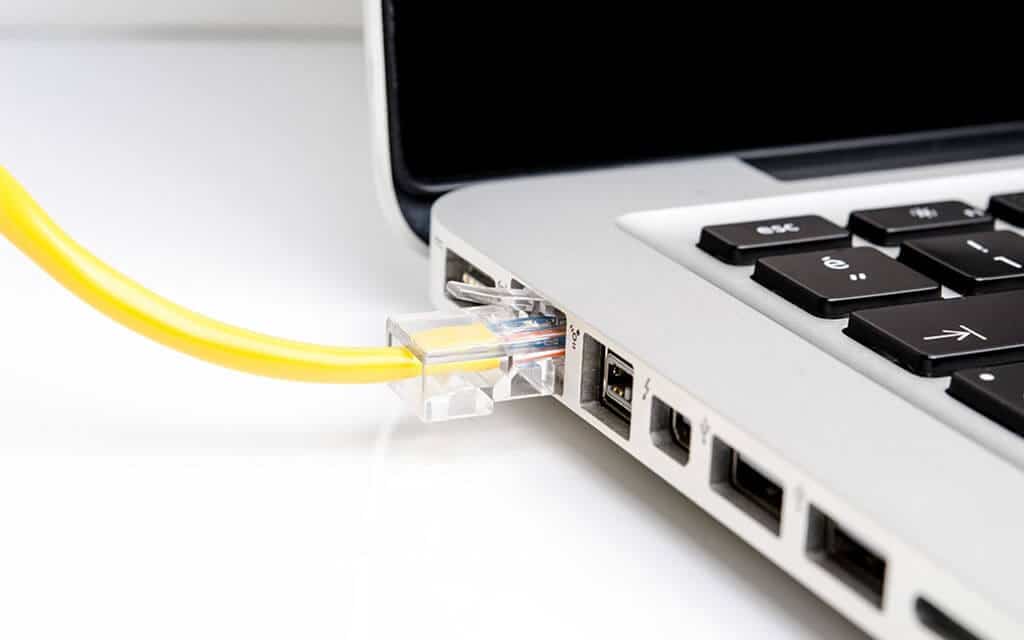
Twitch (or similar) Accounts For Streaming
Finally, you’d need to settle on the platform where you want to stream. While many streaming platforms are available right now, such as YouTube, Facebook Live, and Periscope, Twitch is usually the go-to destination for game streamers. Make sure you have a valid account on any of these streaming platforms and that you’ve configured your streaming software with that account.
Once you’ve got all these devices and tools in place and have configured them correctly, you can then start to stream your favorite games.

Best laptops for Streaming: Quick Answers
What Is Most Important For A Streaming Laptop?
When selecting a laptop for streaming, the most important aspect has to be the processor. Without a multi-core, powerful processor that can handle high-bandwidth streaming, you’re going to face interruptions in your stream. Along with that, a high amount of RAM and a discrete graphics card certainly help the setup.
If you’re looking to get laptops for live streaming (or any video streaming in general), make sure it has at least a 10th generation Intel Core series processor with Turbo Boost technology for overclocking. Also, a graphics card such as Nvidia GeForce GTX is certainly recommended.
What Are The Minimum Specs For Streaming?
The minimum specs you need for streaming depends on the streaming quality that you’re aiming at. For FHD 1080p streaming, we recommend at least a Hexa-core CPU, 16 gigs of DDR4 RAM, and an Nvidia GeForce GTX graphics card.
Of course, if you’re aiming for a lower resolution of stream, then you can do with a quad-core CPU and 8GB of RAM. The graphics card will determine the kind of games that you can stream.
Can Gaming Laptops Handle Streaming?
Long story short, any gaming laptop can handle game streaming as long as it has a powerful CPU/GPU combination and enough RAM. It should also have a high-bandwidth internet connection for playing the game and streaming it simultaneously.
How Much RAM Do You Need For Streaming?
Although 8 GB RAM is the minimum requirement for many games, we recommend at least 16 GB of RAM if you’re looking to hit the streaming sweet spot. Especially for AAA titles, which are more resource-demanding than older games, 16 GB is the bare minimum you should have.
Is Intel Core i5 Good For Streaming?
An Intel Core i5 processor is suitable for streaming, but that’s just it: it’s “good” and not the best. At most, you’ll be able to get a 720p stream at 60fps, and even then, there might be frame drops. So it’s best if you can get a Core i7 or i9 processor in case you’re looking to stream high-res games.
Conclusion
So, now that you know a lot about the best laptop for streaming games, we’re sure you’re ready to get your desired setup. Just remember: streaming games is more resource-intensive than regular content streaming. So, even the best laptop for streaming movies might falter at streaming games.
It’s best to go with at least a 10th gen Intel Core i7 processor and 16 GB of RAM, though the more, the merrier. Also, a high-bandwidth broadband connection is recommended. And in case you’re an extreme gamer who likes to travel, then make sure you’re laptop falls in the military-grade toughness bracket so that it can tackle a few hard knocks here and there.
But that’s about it for now. We’ll be back again with more such laptop-related info. Till then, stay calm and stream on!
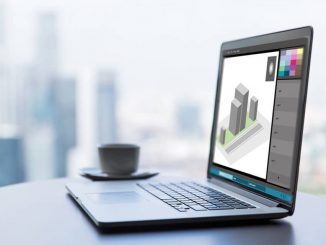

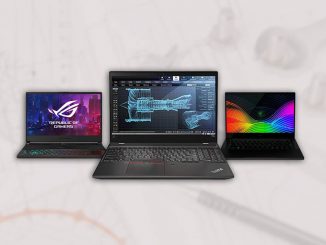

Be the first to comment